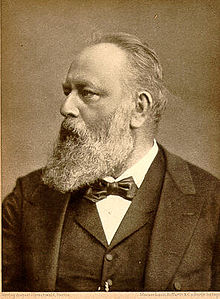Important Medical Dialogues
Ignaz Semmelweis and the Cause of Perinatal Maternal Fever
I. Semmelweis (1818-1865) recognized that the drop in the high mortality associated with the febrile illness that afflicted women on the maternity wards was due to the hygenic practices of the physicians and hospital personnel caring for them. In his era, such thinking was not yet recognized. Although most rejected his ideas, he had some supporters within the medical community (Škoda, Rokitansky, Hebra). They encouraged him, unsuccessfully, to publish his ideas. Therefore, in 1847-49, Hebra took on this task. Today, this is recognized as the first example of evidence-based medicine in Austria. Semmelweis, Professor at the University of Pest as of 1855, had not published anything in the German language before 1861. He died of mental illness, in Vienna, after returning from Hungary.
„Höchst wichtige Erfahrungen über die Ätiologie der in Gebäranstalten epidemischen Puerperalfieber“ >>, F. v. Hebra, in: Zeitschrift der k. k. Gesellschaft der Ärzte zu Wien 4 (1847), S. 242– 244; 5 (1849), S. 64 f.
Theodor Billroth’s Surgical Innovations
Th. Billroth (1829-1894) is known as the father of modern abdominal surgery and as a pioneer of laryngeal and thyroid surgery. Through his bold surgeries and groundbreaking techniques, he became world-famous. Billroth performed the first esophagectomy in 1871 and the first laryngeal extirpation in 1873. However, he is best known for performing the first successful gastrectomy, on January 29, 1881, in a 43 y.o. stomach cancer patient who died 4 months later. Until today, two surgical techniques for gastrectomy (Billroth I and Billroth II) are named after him. His colleagues found him to be well-prepared, in testing his techniques on animals, and regarded him as taking well-calculated risks, in developing his novel approaches. Billroth was also recognized for his research inbacteriology.
„Über 124 vom November 1878 bis Juni 1890 in meiner Klinik und Privatpraxis ausgeführte Resectionen am Magen-Darmcanal, Gastro-Enterostomien und Narbenlosungen wegen chronischer Krankheitsprocesse“ >>, Theodor Billroth in: Wiener klinische Wochenschrift 4 (1891), S. 625-628.
Radiation’s Introduction into Vienna’s Medical Milieu
The discovery of radiation by Wilhelm C. Röntgen (1845-1923) revolutionized medical diagnosis. As early as December 1895, Röntgen wrote to his friend, Franz Exner, who headed Vienna’s second Physics Institute, about his November 8th discovery, i.e. radiation. Thus, Vienna was the site of many novelties in roentgenography.
On December 28th, 1995, Gustav Kaiser, a colleague of F. Exner, presented, for the first time, a medically-indicated radiograph to the world (taken of a patient with a gunshot injury of the hand). Exners’ brother Siegmund, Head of the Physiology Institute, referred to this in the meeting of The Gesellschaft der Ärzte on January 17th, 1896. By January 5th, 1896 the Austrian press had already published an article about the „sensational discovery“. Eduard Haschek and Otto Lindenthal, also colleagues of F. Exner, published the first-ever angiogram in the world on January 23rd, 1896. On this same day, Röntgen, gave his first public lecture, in Würzburg, where he showed the radiograph of his wife’s hand, dated December 22nd, 1895.
„Ein Beitrag zur praktischen Verwerthung der Photographie nach Röntgen“ >>, Ernst Haschek und Otto Lindenthal in: Wiener klinische Wochenschrift 9 (1896), 63-64.
Karl Landsteiner’s Discovery of the Blood Groups
In 1930, K. Landsteiner (1868–1943) received the Nobel prize for Medicine for his discovery of the human blood groups. His research changed the status of medicine worldwide. It made blood transfusion possible; as well, it led to radical improvements in surgical techniques. Medicolegally, it was now possible to prove paternity and to identify bloodstains. In a famous footnote (here), in a publication from 1900, for the first time, Landsteiner suggests that it may be possible to identify human blood types by the affinity of their agglutination characteristics, and not by their pathologic reaction as was the widely-held belief. He based his future work on this assumption; as of 1901, he had already described 3 blood goups A, B and O (which he annotated as “C”). In 1902 Alfredo von Castello and Adriano Sturli found the fourth blood group, AB. Independent from Landsteiner, the Czech serologist, Jan Janský, described the ABO blood group system in a 1907 publication. In the German-speaking medical community, the blood types have been categorized as A, B, AB and O (the figure 0 which is written as the letter O in the English-speaking medical community). In the former USSR, the blood groups were annotated as I, II, III and IV, based upon Jansky’s description.
„Über Agglutinationserscheinungen normalen menschlichen Blutes“ >>, Karl Landsteiner in: Wiener klinische Wochenschrift 14 (1901), S. 1132-1134.
Robert Bárány and Pathology of the Vestibular Apparatus
R.Bárány (1876-1936), physician and neurobiologist, was the first Austrian to win the Nobel Prize in Natural Science (1914). As an assistant in A. Politzer’s otology division, from 1903, he worked on research about the origin of nystagmus with caloric stimulation. He received the Nobel Prize for his work, contained in the 1907 publication (A Study of the Physiology and Pathology of the Inner Ear). During WW I, Bárány served as a surgeon in the Austro-Hungarian army and resumed his otoneurological research while imprisoned by the Russians. Freed, with the help of the Swedish government and Red Cross, Bárány joined the staff of Uppsala University, in Sweden, where he remained employed until his death. On account of Bárány’s new diagnostic and surgical methods, Otology was able to expand its therapeutic options, now offering nonsurgical, in addition to surgical, treatments. Although Bárány’s main research focus was the inner ear, subsequently, he did research in the arthritides affecting the head & neck. You can see some of his early research on the vestibular apparatus here.
„Psychophysiologische Untersuchungen über die Bedeutung des Statolithenapparates für die Orientierung im Raume an Normalen und Taubstummen nebst Beiträgen zur Orientierung mittels taktiler und optischer Empfindungen“ >>, Alexander, G. u. R. Bárány in: Zeitschrift für Psychologie und Physiologie der Sinnesorgane 37 (1904), S. 321-457.

Theodor Billroth






